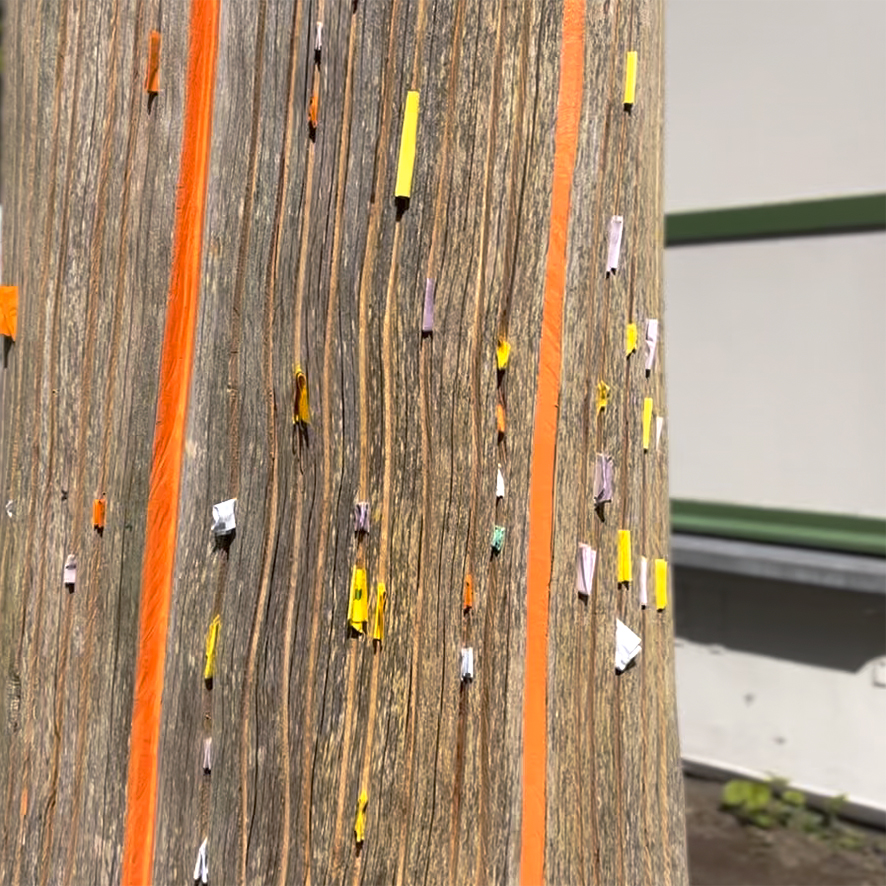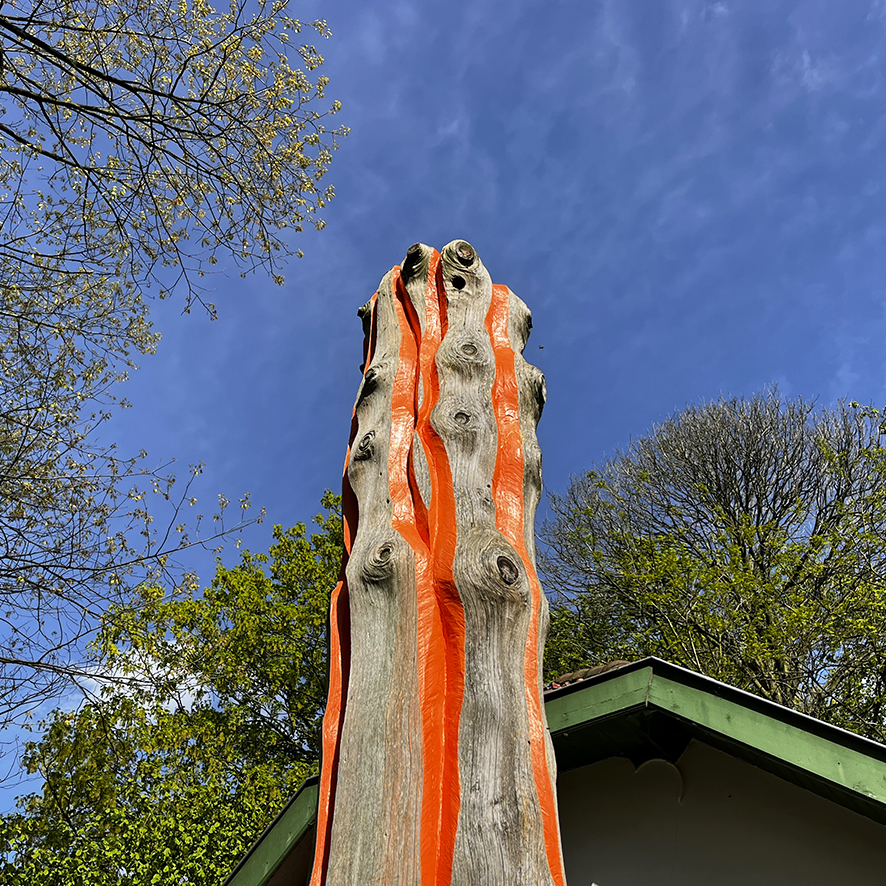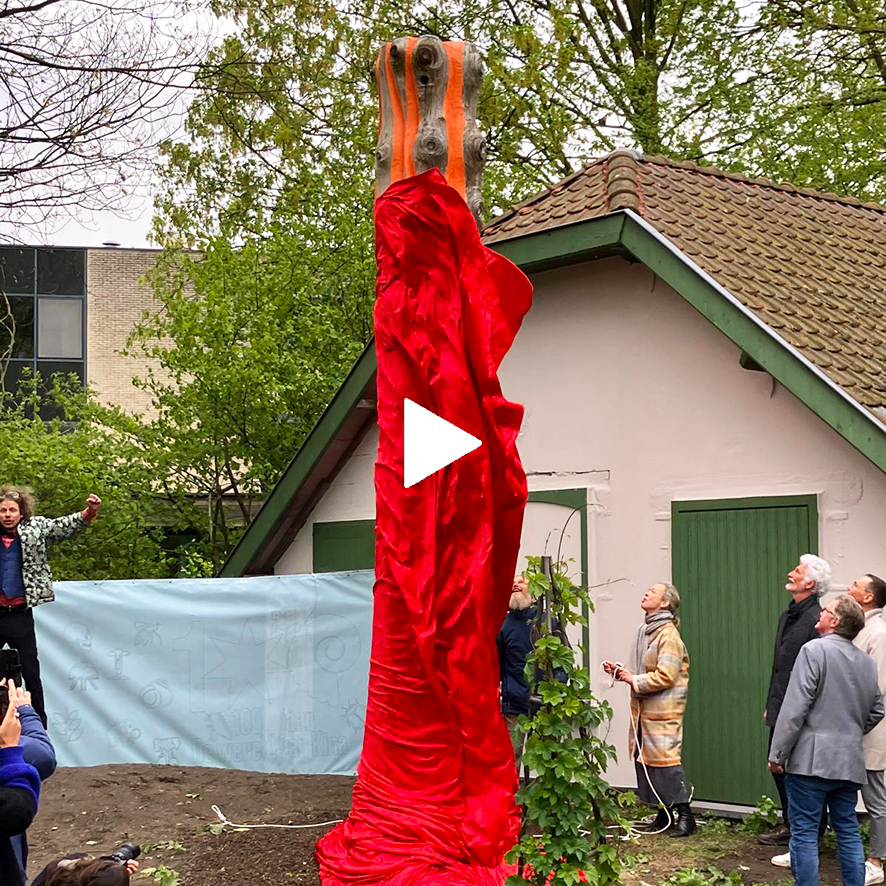Project ‘de Wensboom’
@
de botanische tuin van Kina.
Op vraag van de Stad Gent, gecreëerd ter gelegenheid van 100 jaar De wereld van Kina.
Gemaakt van de op zijn wortels staande Zilverspar die getroffen werd door een blikseminslag.



nl/en
De Wensboom, een creatie voor de tuin van Kina, Gent.
Er is een Beierse legende die vertelt dat lang geleden drie bosarbeiders in het woud een mooie vrouw tegen kwamen. Zij brak van een zilverspar drie takjes af, die ze aan de mannen gaf met de woorden: ‘Dit zijn geluk-takken. Bewaar ze goed!’. Twee van de arbeiders vertrouwden het niet en gooiden de zogenaamde 'heksentakken' weg. De derde stak het takje op zijn muts, waarna het in goud veranderde. De andere twee liepen terug om hun takjes te zoeken, maar ze vonden niets meer. Volgens de legende zoeken ze rond middernacht nog steeds in het woud naar hun zilverspar takjes.
Een sculptuur maken, op een locatie zoals ‘KINA de tuin’ ter gelegenheid van het 100-jarig bestaan, moet per definitie meerdere facetten hebben.
Het moet sowieso eerst en vooral een sculptuur zijn, monumentaal, contrastrijk en sterk, staande op de eigen wortels: een rijzige zilverspar, verwijzend naar zijn eigenheid en groeivorm, met haar zowat symmetrisch staande takken.
Binnen mijn oeuvre valt deze sculptuur in de familie van de zuil-vormen.
Als tweede aspect hoort een sculptuur, in een publieke ruimte zoals deze tuin, iets interactief te hebben. Als je denkt aan de Beierse legende en het feit dat er steeds behoefte is aan hoop en geluk, dan zou een plaats waar ieder zijn wensen discreet kwijt kan, een zegen zijn. In een andere cultuur (India) ben ik een soortgelijke boom tegengekomen. Het is daar een boom waar het fruit aankomt dat je wenst. Deze boom wordt kalpa vriksham genoemd, wat vrij vertaald ‘Wensboom’ betekend.
De sculptuur wordt op een bepaalde hoogte van renuren voorzien zodat kinderen en volwassenen opgevouwen papiertjes met hun wens(-en) in die gleufjes kunnen steken.
Het derde facet gaat over multimedialiteit en dialoog. Dit is mogelijk via een website die www.WensboomGent.be kan noemen.
Deze site bevat wat info en beeldmateriaal over de Wensboom en de omgeving. Maar wat vooral belangrijk is, is het contactformulier waar een wens kan ingevuld worden. In de Kinatuin wordt deze wens dan geprint, opgevouwen en in de Wensboom gestopt (dit kan geïllustreerd worden met een filmpje). Wanneer een contactformulier wordt ingevuld, hebben we het e-mailadres van de bezoeker. Het is bijgevolg mogelijk om meteen en automatisch, een digitale postkaart van de Wensboom terug te sturen met daarop de datum waarop de wens gemaakt werd.
Er is uiteraard plaats voorzien op de website, die de ‘wenser’ kan invullen als er een wens is uitgekomen.
The 'Wensboom', a creation for the garden of Kina, Ghent.
Origin:
There is a Bavarian legend that goes like this : long ago, three forest workers encountered a beautiful woman in the woods. She broke off three twigs from a silver fir, which she gave to the men with the words: 'These are lucky twigs. Keep them safe!'. Two of the workers did not trust it and threw away the so-called 'witch twigs'. The third put the twig on his hat, after which it turned into gold. The other two went back to search for their twigs, but they found nothing. According to the legend, around midnight they still search in the woods for their silver fir twigs.
Creating a sculpture, in a location like 'the Kina garden' on the occasion of the 100th birthday, has by definition several facets.
First and foremost, it must be a sculpture, monumental, contrasting, and strong, standing on its own roots: a tall silver fir, referring to its uniqueness and growth form, with its almost symmetrically standing branches.
Within my oeuvre, this sculpture falls into the family of column forms.
The second aspect is that a sculpture, in a public space like this garden, should have something interactive. Thinking about the Bavarian legend and the fact that there is always a need for hope and happiness, a place where everyone can discreetly leave his wishes would be a blessing.
In another culture (India), I encountered a similar tree. It's a tree where the fruit of your wishes arrives. This tree is called kalpa vriksham, which roughly translates to 'Wish Tree'.
The sculpture will be equipped with slots up to a certain height so that both adults and children can insert their folded papers with wishes into these slots.
The third facet is about multimedia and dialogue. This is possible through a website called www.WensboomGent.be.
This site contains some information and visual material about the Wish Tree and the surroundings. But what is particularly important is the contact form where a wish can be filled in. In the Kina garden, this wish will then be printed, folded, and placed in the Wish Tree. When a contact form is completed, we can send back a digital postcard of the Wish Tree with the date the wish was made.
Of course, there is a blog provided on the website, which the 'wisher' can fill in if his wish has come true.